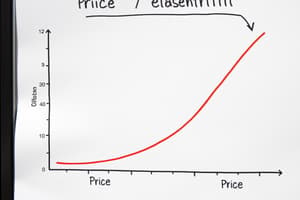Podcast
Questions and Answers
What is the formula to calculate tax incidence for the consumer?
What is the formula to calculate tax incidence for the consumer?
- (ED * (ED - ES))
- (ES * (ED - ES))
- (ED / (ED + ES))
- (ES / (ED + ES)) (correct)
In a market with highly elastic demand and supply, what type of revenue is typically generated by an excise tax?
In a market with highly elastic demand and supply, what type of revenue is typically generated by an excise tax?
- Low revenue (correct)
- No revenue
- Moderate revenue
- High revenue
When demand is inelastic and supply is elastic, who is likely to bear the tax burden according to the text?
When demand is inelastic and supply is elastic, who is likely to bear the tax burden according to the text?
- The government
- Buyers (hotel guests)
- Both buyers and sellers equally
- Sellers (hotel owners) (correct)
Why is understanding tax incidence crucial for effective policy design according to the text?
Why is understanding tax incidence crucial for effective policy design according to the text?
How can knowledge of price elasticity help in designing tax policies, as mentioned in the text?
How can knowledge of price elasticity help in designing tax policies, as mentioned in the text?
What is one potential consequence of heavily taxing one good over another?
What is one potential consequence of heavily taxing one good over another?
How do regressive taxes impact low-income households?
How do regressive taxes impact low-income households?
In what type of market situation may firms with lower prices or higher efficiency gain a competitive advantage due to taxes?
In what type of market situation may firms with lower prices or higher efficiency gain a competitive advantage due to taxes?
How do progressive taxes affect higher-income households?
How do progressive taxes affect higher-income households?
Why is understanding tax incidence considered crucial in policymaking?
Why is understanding tax incidence considered crucial in policymaking?
In a monopolistic market, how does the ability to shift the tax burden compare to a perfectly competitive market?
In a monopolistic market, how does the ability to shift the tax burden compare to a perfectly competitive market?
What impact may a tax on gasoline have on wages in the economy, according to the text?
What impact may a tax on gasoline have on wages in the economy, according to the text?
How can policymakers design taxes effectively, as mentioned in the text?
How can policymakers design taxes effectively, as mentioned in the text?
Why is it important for policymakers to understand tax incidence when designing tax systems?
Why is it important for policymakers to understand tax incidence when designing tax systems?
How does the distribution of tax burdens vary depending on specific circumstances, according to the text?
How does the distribution of tax burdens vary depending on specific circumstances, according to the text?
Flashcards are hidden until you start studying
Study Notes
Elasticity and Tax Incidence: Exploring the Interplay Between Price Elasticity and Tax Burden
Tax incidence, a fundamental economic concept, helps us understand the distribution of a tax burden between buyers and sellers. This article delves into the intricacies of elasticity, particularly price elasticity, in the context of tax incidence.
Price Elasticity of Demand (ED) and Supply (ES)
Price elasticity, represented by the formula:
ED = (% change in quantity demanded / % change in price)
ES = (% change in quantity supplied / % change in price)
These values determine how sensitive a good's demand and supply are to changes in price. The elasticity values can range between (-1) and (+1), where (-1) denotes a perfectly elastic good, (0) a unit elastic good, and (+1) an inelastic good.
Tax Incidence and the Relative Elasticity of Demand and Supply
To understand tax incidence, we compare the relative elasticities of demand and supply. Typically, the tax burden falls on the side with the lower elasticity.
-
If the demand is more elastic than supply (ED > ES), the buyers will bear the majority of the tax cost, as they can more easily reduce their quantity demanded in response to price increases.
-
If the supply is more elastic than demand (ES > ED), the sellers will bear the majority of the tax cost, as they can more easily increase their quantity supplied without too much price movement.
Formulas for Determining Tax Incidence
To calculate tax incidence, we can use the following formulas:
For the consumer:
Tax Incidence (%) = (ES / (ED + ES))
For the supplier:
Tax Incidence (%) = (ED / (ED + ES))
Elasticity and the Impact on Tax Revenue
In a market where both demand and supply are highly elastic, the imposition of an excise tax generates low revenue. Conversely, where demand and supply are inelastic, the revenue generated by the tax can be higher.
Examples of Tax Incidence
For instance, think of beachfront hotels:
-
If demand is elastic (hotel guests have many alternative vacation options) and supply is inelastic (hotel owners cannot easily relocate their properties), tax incidence would likely fall on the buyers (guests).
-
If demand is inelastic (hotel guests have limited vacation options) and supply is elastic (hotel owners can easily buy or build more properties), tax incidence would likely fall on the sellers (hotel owners).
Implications for Policy
Understanding tax incidence, particularly through price elasticity, is crucial for effective policy design. The government can use this knowledge to ensure that taxes are distributed in a fair and efficient manner.
In conclusion, the concepts of price elasticity and tax incidence are vital to understanding how taxes affect buyers and sellers. By recognizing the relative elasticity of demand and supply, we can identify the party that bears the majority of the tax burden and design tax policies accordingly.
Studying That Suits You
Use AI to generate personalized quizzes and flashcards to suit your learning preferences.




